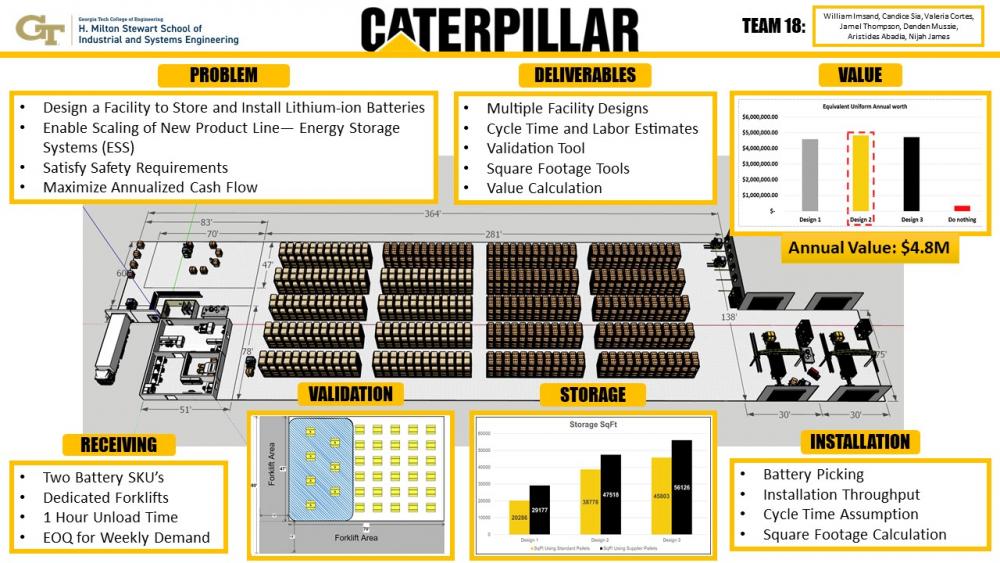Client Context
Caterpillar Inc. currently produces ESSs inside their Primary Manufacturing Facility on the Griffin, GA Campus. They store batteries for ESS installments in small batches and produce one ESS at a time. They build to order and once this order is made, they signal a request to their battery supplier. At their current state, Caterpillar cannot produce ESSs at scale, hindering their ability to market these products. This is primarily because of the significant lead-time of 6-9 months. Caterpillar is looking for a solution that acts as a cost driver. They want a warehouse recommendation that can meet potential demand, meet all safety requirements, and provide operators the ability to work safely, efficiently, and ergonomically.
Project Objective
Design Problem Overview
The design problem objective is to provide a facility design to maximize equivalent annual worth subject to several in-house and OSHA constraints. These include proper storage temperature, proper fire safety equipment, in rack sprinkler systems, and proper Personal Protective Equipment for operators working in the facility among other requirements. The equivalent annual worth includes the upfront architectural design and construction of the facility plus the operational costs over a time horizon of 10 years.
Project Opportunities
2.1.1 ESS Demand Growth and Future Expansion
Using an 8% Compound Annual Growth Rate (CAGR) obtained from market analysis growth reports for ESSs, we predict that Caterpillar’s ESS demand will double by 2030 (appendix C). According to the market analysis, we need to make sure there is an opportunity for the facility to be able to expand operations to meet demand growth. Using this information, we designed 3 facilities based on different demands that account for future expansion while maintaining a safe operational model.
2.1.2 Safety
Due to the hazardous nature of Lithium-ion batteries, we must ensure the process flow is safe and repeatable from the time the batteries enter the facility, to when they leave. Lithium-ion batteries are prone to explode when damaged, stored incorrectly, or improperly charged. Our priority when designing the facility was to mitigate as many of these risks as possible. Our designs therefore incorporate safety requirements from a Caterpillar Facility Project Engineer, Caterpillar’s insurance company (FM Global), and the Occupational Safety and Health Administration (OSHA) as hard constraints.
2.1.3 Pallet Assumptions
Based on the current supply chain issues, battery suppliers and therefore pallet sizes may change. To address this, we created three designs that used industry standard pallet dimensions for all battery sizes as instructed. Then we created three alternative designs using the measured pallet dimensions for the large batteries as observed during a site visit. The extra size of the current pallets requires a significantly larger facility footprint. The additional designs enable Caterpillar to compare their current supplier to potential facility recommendations using their preferred assumptions.
Design Strategy
Given the functions identified earlier, our first step was to determine the demand of ESSs and hence the number of batteries that must be accommodated by the facility. Then we discuss design decisions for each function.
Currently, precise estimates for ESS demand are unknown. We know that an average of 80 small storage systems will be produced per year initially. Small, 6 rack systems are the most demanded ESS. Per Caterpillar’s market research, we estimated that large ESS systems will be consistently less popular and set demand forecasts at 75% of small ESS demand.
Using this assumption, we created our first design scenario: 80 small ESSs plus 60 large ESSs for a total demand of 140 ESSs during the first year. To create our second scenario, we used the CAGR discussed earlier (8%), to determine the doubling period for the ESS demand. It will take approximately 10 years for the demand to grow to 280 ESSs annually. We used this estimate to consider the request for an expandable facility capable of meeting a wide range of demands. Lastly, considering a more aggressive growth rate, we assigned our highest potential annual demand to be 315.
Each design has a max throughput greater than the targeted demand due to storage dimensions and rack size. Therefore, all designs can handle the initial estimated demand of 140 ESSs annually as well as some potential growth in demand.
Using these demand estimates as a base for the three facility designs, we created an Excel tool assuming a normal distribution with 99.5% confidence intervals for both large and small batteries. We chose 99.5% Confidence intervals due to Caterpillar’s request of meeting 99.5% of the demand for each estimate.
We addressed variation by separating ESSs by battery SKU and number of racks. The more demanded ESS types were weighted more heavily in the tool. We used probabilities to account for the differences in rack type demand. For the small battery type, we placed more weight on the ESS with 6 racks due to its higher demand. We assumed each rack type in the large ESSs have an equal probability of being ordered. From past conversations, we assume there will be low variability in the system, so we set the coefficient of variation for ESS types to 0.1.
With these annual demand ranges we created a Material Resource Plan (MRP) using the economic order quantity heuristic (EOQ) to calculate the maximum number of each battery SKU needed to be stored at once to meet the respective demands.
Deliverables
As part of our agreement, we have provided 3 design options using the standard pallet assumption and 3 designs using LG Chem pallet assumption. We have also included several tools that have been detailed in earlier sections of the report. As value added, the tools can be used in parallel with the design decisions we made and in the absence of them. As new demand information becomes available Caterpillar can use these tools to create new designs based on better forecasts. All are interactive and update based on the inputs. The full list of deliverables is summarized in appendix:
- Facility Floor Plans
- 6 total facility floor plans for each assumption and demand estimate
- Cycle Time and Labor Estimation Tool
- Estimates cycle time and labor needed for each process in facility
- Parameterized to update the cycle time based on the number of forklifts and workers
- Cycle Time and Labor Estimates
- Provided cycle time and labor estimates for each design option
- Validation Tool
- Calculates the total number of batteries to sample for a given lot size
- Outputs the maximum allowable defects and number of defects resulting in failure of the sample size
- Returns status of the lot based on number of failures
- Square footage Calculation Tools
- Annual Battery demand estimation tool
- Creates confidence interval of battery demand based on averages
- Economic Order quantity script in python
- Provides optimal order quantity and reorder point
- Material Resource Plan
- Outlines the number of batteries needed per week
- Displays trucks needed per week
- Gives maximum number of batteries stored in facility
- Storage Calculation tool
- Determines the total required square footage of the storage room
- Inputs:
- Annual demand for large and small ESSs
- Expected annual battery consumption & rack size
- Required aisle space to determine the total required square footage of the storage room
- Compares multiple options for number of subsequent racks and the number of rows of racks to determine the storage dimensions
- The tool highlights the design that minimizes total square footage of the storage room based on dimensions
- These calculations are repeated for the standard pallet scenario as well as the LG Chem scenario
- Value Calculation Tool
- Provides cash flows and annual worth over 10-years based on number of employees and space estimates
- 3-D Facility Designs


